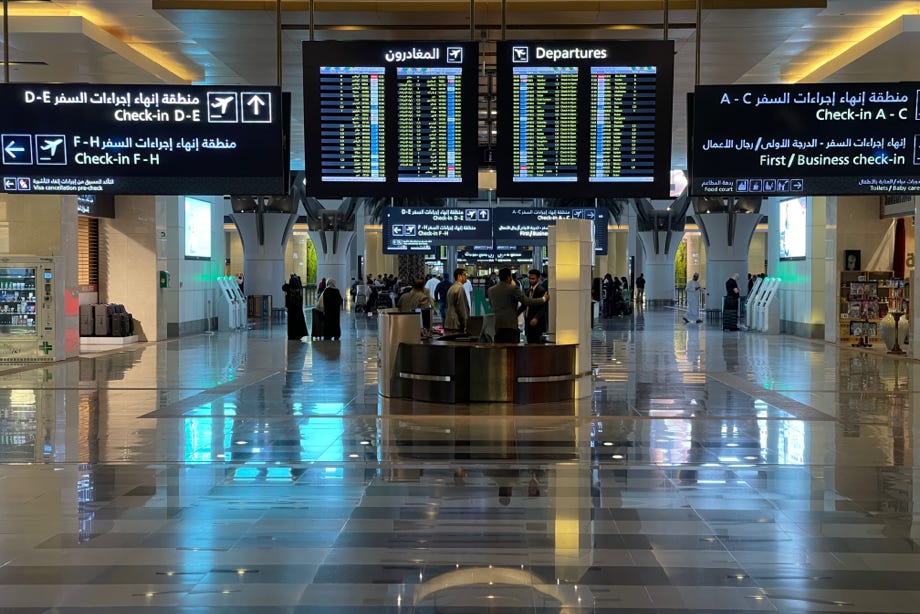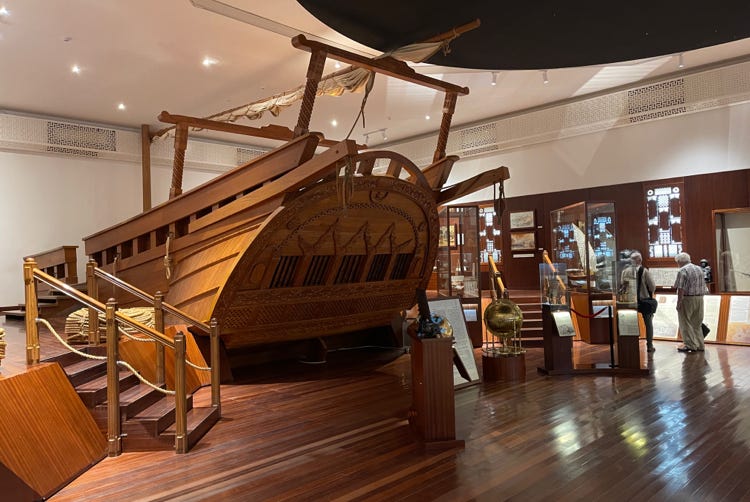Salalah is Oman’s second largest city, located about 850 kilometres by air south-east of Muscat on Oman’s southern coastline facing the Indian Ocean. Capital of Dhofar, Oman’s southernmost province, it is situated just 150 kilometres by road from the border with Yemen. It is also known as the “Perfume capital of Arabia” because so many frankincense trees grow in the region (and almost nowhere else).
Salalah’s peak tourism season is in summer when the ‘khareef’ (south-eastern monsoon) brings rain, heat and humidity that transform the region into a verdant green garden-like, mist-shrouded environment that can only be an imaginative fantasy in winter (i.e. now) when the landscape is as brown and arid as the rest of the Arabian Peninsula. Winter does, however, offer excellent hotel rates and an absence of mist-loving crowds who crave high rates of humidity.
Driving from Muscat to Salalah requires a drive of just over 1,000 kilometres that takes about ten hours with absolutely nothing of interest to see on the way – no trees, almost no settlements, not even any interesting rocks. This didn’t seem like a wise use of my scarce time in Oman, so I chose to fly instead – an excellent decision.
In order to catch the daily flight to Salalah I had to miss breakfast at the hotel and drive to the airport at about 6:30am. I’m glad I allowed a bit of “wiggle room time” because when I arrived at the car rental return area the Thrifty office (the company I had used) was – uniquely among all the offices – unstaffed.
The representative in the adjoining office helpfully phoned the Thrifty representative for me, and about ten minutes later he arrived very apologetically. Finishing the return process then took a further 15 minutes, but everything was happy, cordial and extremely relaxed.
Getting through the airport’s processes was very quick and efficient for three reasons. First, I had done an online check-in yesterday. Second, I (as usual nowadays) only had hand luggage, and third, Muscat Airport is one of the best I have encountered in the world. Only about five years old and ambitious in its scale and design, it is far from overcrowded and everything “just works” the way it should with friendly and efficient staff.
This was first flight in an infamous Boeing 737 MAX (the type of airliner that was grounded for a few years after two crashes caused by its combination of unstable flight dynamics and deficient software that had been secretly installed to short-circuit its approval process). Of course, since the software was fixed and the plane was re-approved for normal operations, it has flown without any more issues than any other airframe.
My flight to Salalah was on an Oman Air Boeing 737-8 MAX, registration A4O-MG. It was a really good flight with fabulous views of Oman’s mountainous areas and excellent food for a 90 minute flight that the airlines I usually fly would do well to emulate.
The plane took off about 5 minutes late and landed about 10 minutes late, which is well within normal operations. Being a domestic flight, exit from the terminal was very quick and I headed straight to the rental car desk (Avis this time). As though history was destined to repeat itself, the Avis booth was – uniquely among all the rental car booths – unattended. Once again, the helpful attendant at a competing booth across the passageway phoned the Avis representative who said he would be there in a few minutes.
He arrived thirty minutes later saying he had to get some cars washed. He couldn’t find my reservation for about ten minutes, but eventually he said that to apologise for all the delays he would give me a larger car. I said I’d prefer the smaller one I had ordered, but he insisted on upsizing to a Mazda 6. When we went outside to the parking area I saw that my Mazda was unwashed and quite dirty, whereas the car I had ordered (which was parked next to it) looked pristine by comparison. Of course, by that time, the paperwork was all in place for the Mazda, so that’s what I have for the next four days. (Interestingly I wasn’t given a copy of any of that paperwork; I don’t think Avis in Salalah is one of their flagship operations).
The drive from the airport to my hotel was about 20 kilometres, slightly complicated because Google’s algorithms seem somewhat imprecise in this part of the world. At least, I reached that conclusion when its directions tried to take me through the fortified gates of an army barracks, across a bridge that doesn’t exist, and along a two kilometre stretch of the main beach on the seafront while refusing to engage with any section of the parallel road about 300 metres inland.
By the time I got to my hotel room (which is lovely), I had about a third of the day’s daylight remaining. I had worked out that the next two days (Friday and Saturday) would be the weekend, which meant many places would be closed. Therefore I decided to spend what remained of the afternoon visiting Salalah’s main (many would say only) attraction, the Frankincense Museum and the adjoining Al Baleed archaeological site.
Ignoring Google’s instructions to drive along the beachfront and make a right turn through the lobby of another hotel, I followed the main road and located the museum’s car park easily. The person who was supposed to be selling the entry tickets seemed to be missing, so a nearby security officer suggested I start my visit and call back later to pay.
I had heard that the Al Baleed archaeological site has fixed times when it is closed but variable times when it is open. It happened to be open when I arrived, so I decided to visit there before the Museum. Walking past a lovely grove of frankincense trees and over a metal bridge, I entered Al Baleed, not knowing beforehand that it is a UNESCO World Heritage site.
My visit was a real education. Situated on a strip of land between the ocean and a small inland lagoon, there has been a settlement on the site since about 2500BC, which was during the Bronze Age. At the end of the lron Age (between 5AD and 6AD), the settlement became a city with administrative functions, and during the period 750 to 950 it became an active commercial centre, expanding to become a regional power between 1000 and 1200. It was a major trading centre, focussing especially on the export of frankincense, with trading links as far away as India, South-east Asia, China, and the ports of East Africa by the year 1300. Marco Polo apparently visited in 1280 and was impressed by the colour and vibrancy of the place, especially its trading activity.
It was less vibrant today for my visit. Apart from three young Indian men who entered the site, had their photos taken beside a ruined building and then left, I was the only person present for the couple of hours of my visit (I’d like to think others were waiting for the ticket office to open, but that’s a bit fanciful).
Although many of the buildings were little more than foundations and some piles of stones, several of the buildings had substantial remains, especially several mosques and the lower parts of the city walls. It must have been quite an impressive settlement in its heyday – my walk through the site covered a distance of 4.5 kilometres (see image of the route).
It may be winter in Salalah, but the temperature is much warmer than in Muscat. I suppose that is to be expected, as Salalah is almost a thousand kilometres closer to the equator than Muscat. The temperature this afternoon while I walking through the ruined city of Al Baleed was 26°C, but fortunately it was not too humid even though it is on the coast. I have no doubt that the temperature was considerably warmer than 26°C in the full sun where I spent the afternoon walking.
I returned to the entry area and dutifully paid my entry fee, which was 3 rials (about $Aust 11), payable only with a credit card; no cash accepted.
The entry fee also included the Frankincense Museum. The museum is small and built in a courtyard style with a frankincense tree in the middle. There are several exhibition halls but only two were open, the Maritime Hall and the History Hall. Both were excellent, with very well laid out displays that were explained clearly and concisely. I should add that the air conditioning was also working very well. Interestingly, and (to me) surprisingly, the Museum was far more popular than the Al Baleed archaeological site.
I returned to my hotel feeling somewhat physically tired after the afternoon’s explorations. I decided to have a small snack-like dinner in the hotel of nachos. This was the first meal I have ever had in Oman that wasn’t excellent. In fact, this meal was terrible. It wasn’t even nachos – nachos are not a bowl of plain corn chips with three tiny (2.5 centimetres diameter) shallow mini-ramekins on the side containing salsa or cheese sauce. Moreover, that bowl of corn chips shouldn’t cost 4.80 rials ($Aust 17.50).
Okay, my rant is over – time for a good sleep and prepare for tomorrow’s Friday travels.





















